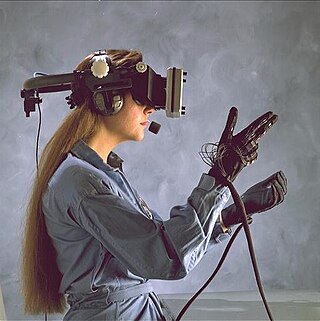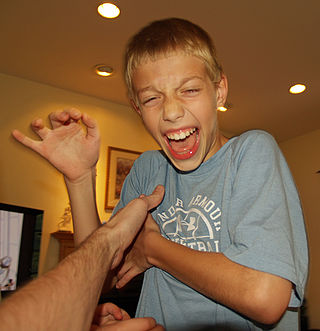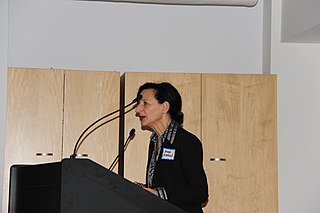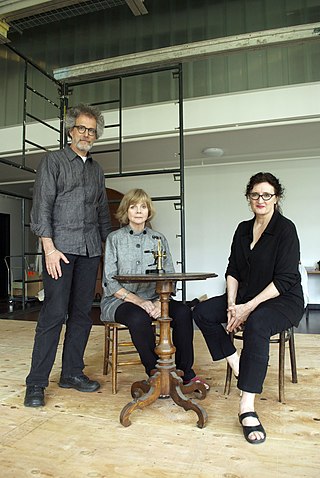Related Research Articles

Simon Fraser University (SFU) is a public research university in British Columbia, Canada, with three campuses, all in Greater Vancouver: Burnaby, Surrey, and Vancouver. The 170-hectare (420-acre) main Burnaby campus on Burnaby Mountain, located 20 kilometres (12 mi) from downtown Vancouver, was established in 1965 and comprises more than 30,000 students and 160,000 alumni. The university was created in an effort to expand higher education across Canada.

Physical intimacy is sensual proximity or touching. It is an act or reaction, such as an expression of feelings, between people. Examples of physical intimacy include being inside someone's personal space, holding hands, hugging, kissing, caressing and sexual activity. Physical intimacy can often convey the real meaning or intention of an interaction in a way that accompanying speech cannot do. Physical intimacy can be exchanged between any people but as it is often used to communicate positive and intimate feelings, it most often occurs in people who have a preexisting relationship, whether familial, platonic or romantic, with romantic relationships having increased physical intimacy. Several forms of romantic touch have been noted including holding hands, hugging, kissing, cuddling, as well as caressing and massaging. Physical affection is highly correlated with overall relationship and partner satisfaction.

Haptic technology is technology that can create an experience of touch by applying forces, vibrations, or motions to the user. These technologies can be used to create virtual objects in a computer simulation, to control virtual objects, and to enhance remote control of machines and devices (telerobotics). Haptic devices may incorporate tactile sensors that measure forces exerted by the user on the interface. The word haptic, from the Greek: ἁπτικός (haptikos), means "tactile, pertaining to the sense of touch". Simple haptic devices are common in the form of game controllers, joysticks, and steering wheels.

Haptic communication is a branch of nonverbal communication that refers to the ways in which people and animals communicate and interact via the sense of touch. Touch is the most sophisticated and intimate of the five senses. Touch or haptics, from the ancient Greek word haptikos is extremely important for communication; it is vital for survival.
Mark Leier is a Canadian historian and, since 1994, a professor of working class and left-wing history at Simon Fraser University (SFU). From 2000 to 2010, he was the director of the Centre for Labour Studies at Simon Fraser.
Linda Marie Harasim, is a "leading teacher, scholar and speaker on the theories and practices of online education, contributing knowledge, technologies, and practices to the field of technology-enabled learning," is a pioneer leading theorist of online education. She is a professor emerita in the School of Communication at Simon Fraser University (SFU) in Vancouver, British Columbia, Canada. Her six books and hundreds of articles about Computer-supported collaborative learning have been acknowledged as seminal works in the field.
Haptic perception means literally the ability "to grasp something". Perception in this case is achieved through the active exploration of surfaces and objects by a moving subject, as opposed to passive contact by a static subject during tactile perception.
New Extreme Films describes a range of transgressive films made at the turn of the 21st century that caused scandal and controversy, and provoked significant debate and discussion. They were notable for including graphic images of violence, especially sexual violence and rape, as well as explicit sexual imagery.

In physiology, the somatosensory system is the network of neural structures in the brain and body that produce the perception of touch, as well as temperature (thermoception), body position (proprioception), and pain. It is a subset of the sensory nervous system, which also represents visual, auditory, olfactory, and gustatory stimuli.

Established in 2009, the Faculty of Communication, Art and Technology (FCAT) at Simon Fraser University in British Columbia, Canada encompasses 5 Schools and Programs.

Sara Louise Diamond, is a Canadian artist and was the president of OCAD University, Canada.

Ethnocinema, from Jean Rouch’s cine-ethnography and ethno-fictions, is an emerging practice of intercultural filmmaking being defined and extended by Melbourne, Australia-based writer and arts educator, Anne Harris, and others. Originally derived from the discipline of anthropology, ethnocinema is one form of ethnographic filmmaking that prioritises mutuality, collaboration and social change. The practice's ethos claims that the role of anthropologists, and other cultural, media and educational researchers, must adapt to changing communities, transnational identities and new notions of representation for the 21st century.
Althea Thauberger is a Canadian visual artist, film maker and educator. Her work engages relational practices rooted in sustained collaborations with groups or communities through social, theatrical and textual processes that often operate outside the studio/gallery environment. Her varied research-centric projects have taken her to military base, remote societies and institutional spaces that result in performances, films, videos, audio recordings and books, and involve provocative reflections of social, political, institutional and aesthetic power relations. Her recent projects involve an extended engagement with the sites of their production in order to trace broader social and ideological histories.

Patricia Gruben is an American born filmmaker who taught film studies at Simon Fraser University in British Columbia, Canada until 2018. As a director, she has made four feature films and a number of shorts. Gruben has worked in many different positions within the film industry, from being property master to directing a feature film. In 2015, Gruben was the recipient of the Teamsters 155 Woman of the Year Award given by Vancouver Women in Film and TV.
Giuliana Bruno is a scholar of visual art and media. She is currently the Emmet Blakeney Gleason Professor of Visual and Environmental Studies at Harvard University. She is internationally known as the author of numerous influential books and articles on art, architecture, film, and visual culture.
Ali Badrakhan is an Egyptian film director and screenwriter, the son of the director Ahmed Badrakhan. He worked as assistant to Fatin Abdel Wahab in Land of Hypocrisy in 1968, and with Youssef Chahine in the films Selection in 1971 and The Sparrow in 1974; his first movie was The Love That Was (1973) by Soad Hosny. Badrakhan collaborated with Naguib Mahfouz, Salah Jahin, and Ahmed Zaki.
Kamala Todd is a filmmaker, community planner, and curator based in Vancouver, British Columbia. She is of Métis, Cree and European descent. Her writing, films, and curatorial practice often revolves around the topic of Indigineity in Canada.

Samantha Gorman is an American game developer known for her combination of narrative, theatricality and gaming in VR environments, and for introducing gestural interactions in touchscreen narratives. She has won multiple awards for her work, both in the field of games and in electronic literature and new media writing. Gorman co-founded the computer art and games studio Tender Claws in 2014 and has been an assistant professor at Northeastern University since 2020.

Stephanie Simmons is a Canadian Research Chair in Quantum Computing at Simon Fraser University. She was named by Caldwell Partners as one of Canada's Top 40 Under 40 in 2020. Her research considers the development of silicon-based systems for quantum computing. She is the founder and Chief Quantum Officer at Photonic Inc., a spin out company which focusses on the commercial development of silicon photonics spin qubits.
Selma Wassermann is a Canadian-American author, educator, and researcher. She is a Professor Emerita at Simon Fraser University, where she led the creation of the teacher education program.
References
- ↑ "Laura Marks, 2010". Department of Art, Northwestern University. 2010.
- ↑ "Curriculum Vitae". Simon Fraser University.
- ↑ "Dr. Laura U. Marks". ISEA International . Retrieved October 8, 2020.
- ↑ Forbes, Angus (August 11, 2006). "Haptic Visuality". Department of English, University of California, Santa Barbara . Retrieved October 8, 2020.
- ↑ "Arab Glitch: A Film Series". University of Rochester. March 4, 2014.
- ↑ Martin-Jones, D. (December 2002). "The Skin of the Film: Intercultural Cinema, Embodiment and the Senses". Screen. 43 (4): 442–446. doi:10.1093/screen/43.4.442.
- ↑ Barlow, Melinda (October 2004). "Review of Touch: Sensuous Theory and Muitisensory Media". Canadian Journal of Film Studies. 12 (2): 126–129. doi:10.3138/cjfs.12.2.126. ISSN 0847-5911.
- ↑ Gauthier, Sean (2006). "Review of Touch". Canadian Journal of Communication . 61.
- ↑ Osborn, J.R. (November 2011). "Review of Enfoldment and Infinity". Design and Culture. 3 (3): 409–411. doi:10.2752/175470811X13071166525775. ISSN 1754-7075. S2CID 144635329.
- ↑ Roman, Mathilde (May 20, 2017). "Laura U. Marks, Hanan al-Cinema: Affections for the Moving Image". Critique d'art (in French). doi: 10.4000/critiquedart.21285 . ISSN 1246-8258.
- ↑ Valassopoulos, Anastasia (May 2017). "Review of Hanan al-Cinema". International Journal of Middle East Studies . 49 (2): 355–357. doi:10.1017/S0020743817000198. ISSN 0020-7438.